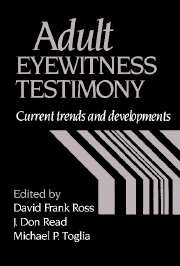Book contents
- Frontmatter
- Contents
- List of contributors
- Preface
- Part I Cognitive, physical and social processes and factors influencing eyewitness recall and identification
- 1 Reports of suggested memories: Do people truly believe them?
- 2 Memory source monitoring and eyewitness testimony
- 3 Understanding bystander misidentifications: The role of familiarity and contextual knowledge
- 4 Unconscious transference and lineup identification: Toward a memory blending approach
- 5 Earwitness evidence: Memory for a perpetrator's voice
- 6 Whole body information: Its relevance to eyewitnesses
- 7 Actual victims and witnesses to robbery and fraud: An archival analysis
- Part II Lineup construction and collection of testimony
- Part III Whom to believe? Distinguishing accurate from inaccurate eyewitnesses
- Name index
- Subject index
5 - Earwitness evidence: Memory for a perpetrator's voice
Published online by Cambridge University Press: 04 August 2010
- Frontmatter
- Contents
- List of contributors
- Preface
- Part I Cognitive, physical and social processes and factors influencing eyewitness recall and identification
- 1 Reports of suggested memories: Do people truly believe them?
- 2 Memory source monitoring and eyewitness testimony
- 3 Understanding bystander misidentifications: The role of familiarity and contextual knowledge
- 4 Unconscious transference and lineup identification: Toward a memory blending approach
- 5 Earwitness evidence: Memory for a perpetrator's voice
- 6 Whole body information: Its relevance to eyewitnesses
- 7 Actual victims and witnesses to robbery and fraud: An archival analysis
- Part II Lineup construction and collection of testimony
- Part III Whom to believe? Distinguishing accurate from inaccurate eyewitnesses
- Name index
- Subject index
Summary
Earwitness testimony, in contrast to eyewitness testimony, has not received a great amount of attention from either psycholegal researchers or the courts, possibly because of the greater reliance on information processed visually rather than orally. Some crimes may include both visual and auditory information, or may only be seen but not heard. For some crimes, however, such as those committed in darkness, or with perpetrators wearing masks, or those committed over the telephone, the sole source of identification evidence may be auditory.
Experimental research on earwitness testimony has been pursued by researchers in North America, the United Kingdom, and Europe (see reviews by Bull & Clifford, 1984; Clifford, 1983; Deffenbacher, Cross, Handkins, Chance, Goldstein, Hammersley, & Read, 1989; Hammersley & Read, in press; Kunzel, 1990). This research has had only limited impact on police practices and on the courts (see Yarmey, 1990), however, and has not been widely reported in the mass media. For example, Kleiman (1988) reported in the New York Times that prosecutors in a Riverhead, Long Island, trial believed their use of a voice lineup as the primary method to identify an accused serial rapist was a ground breaking procedure in criminal proceedings. English courts have accepted voice identification evidence from lay witnesses at least since 1660 (Hollien, Bennett, & Gelfer, 1983). If the Times article is representative of the general knowledge of officers of the court, the construction of voice lineups and judgments about the influence of selected estimator and structural factors on earwitness identifications are based on intuition or common knowledge rather than on scientific findings and theory.
- Type
- Chapter
- Information
- Adult Eyewitness TestimonyCurrent Trends and Developments, pp. 101 - 124Publisher: Cambridge University PressPrint publication year: 1994
- 12
- Cited by



